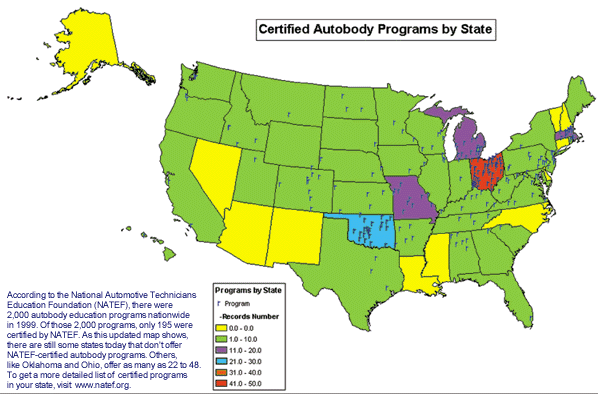A Missouri student turned in a research paper for his English class. The assignment: Write about a profession. This student chose the collision repair industry. He’d done a great deal of research and had written a fine paper. I know. I saw it. After handing it in to be graded, the student anxiously awaited getting it back – sure he would get at least a “B” but more likely an “A.”
What he got was a big, red “F.”
Positive this was a mistake, the student went to the teacher and asked what had happened. She responded, “The assignment was to write about a profession. Working on cars is not a profession.”
To understand why educators feel this way about our industry – and to properly answer autobody instructor Dan McClellan’s question – we need to look at a number of factors and issues.
The History of Mentoring and Apprenticeships
Let’s begin by considering the history of the skilled trades and how the skills were passed from masters to beginners.
In ancient Greece, young boys were paired with older, experienced men so each boy would learn and emulate the values of his “mentor.” Basic survival skills, culture and values were learned directly from others whom they admired.
Later, young boys were “apprenticed” to a master in his trade who owned a shop or business. The boy lived with the master, worked his way up to journeyman and finally became a master himself. Out of this came craft guilds, which controlled the quality of work and wages.
The master/apprentice relationship was eventually transformed into the employer/employee relationship by the industrial society. But in the 20th century, for reasons still being studied by sociologists, it became “less than desirable” to seek skilled trade positions. College degrees became the focus and were associated with the only way to truly succeed in life and make a decent living.
Why “Good Students” Go to College
Most educators and nearly all school administrators view education as the only way to go. Who could argue with that? Life-long learning is the best education, but I would argue that this doesn’t necessarily have to occur in a school setting. The problem is, many principals and guidance counselors are evaluated based on the percentages of students who graduate from high school and go on to a post-secondary institution. And this becomes a deterrent to sending students to vocational-technical schools.
What they don’t track, however, is how many students actually go on to earn a degree. A large percentage drop out of college, try to make a living without any marketable talents and end up coming back to their local community college to learn a skill. That’s a big reason why the average age of community college students is in the upper-20s.
In some states, high schools receive revenue for each student seated in a chair at two different times during each day of the week. By sending students to a vocational-technical school, either in the morning or afternoon, the school loses part of that revenue.
So which students do you think they’re willing to “get rid of”? The problem students – those who cause trouble in school and who administrators feel have no chance of making it in college.
I remember one case in Pennsylvania where a high school student told his counselor he wanted to attend the local vocational-technical school. The counselor wouldn’t allow it, saying this student’s grades were “too good” and that he was “college material.” He and his parents appealed to the principal, but to no avail. They then appealed to the superintendent – who backed the principal. Not until they got their congressional representative to write a letter of appeal to the school were they able to enroll this young man in a vocational program. That tells you a bit about the mind-set of some people out there. It took nothing short of an act of Congress to persuade these administrators to reluctantly change their minds.
Does that make your blood boil like it does mine?
The Poor Red-Headed Stepchild of the Education System
We know that in most cases – though major exceptions exist in some parts of the country – vocational education is the poor stepchild of the education system. And collision repair training programs are the poor stepchild of vocational education.
There are about 1,400 collision repair training programs out there, and only around 200 of these are ASE-certified. Of those that aren’t certified, some are very good, some are just OK and a lot are so lacking that they’re a waste of everyone’s time and of taxpayer money. And a few of these poor programs tarnish the image of all.
Compounding the problem is that a number of instructors have tenure and feel no obligation to stay up to date by offering a valuable training program. They’re just looking forward to retirement and make no extra effort to serve their students or the industry that would love to hire properly trained students. Again, a few bad, tenured instructors tarnish the image of all.
On average, all collision repair training programs are woefully underfunded. And they don’t stand much of a chance to increase the support they get from their local school districts unless they have a strong, vocal advisory committee – and even then it’s an uphill battle.
It’s not cheap to train people to today’s standards. If you add up the ASE/NATEF tool and equipment list and tried to purchase everything on it, the cost would be more than $400,000! In my travels across the country, I’ve noticed that it’s not unusual to find annual school budgets less than 1 percent of that; in fact, it was more the norm.
Another issue is that vo-tech education only fills about 25 to 27 percent of the industry’s entry-level needs; only three to five students out of an average class of 20 graduate from a two-year training program and go on to work in the industry. These numbers hurt the training program’s ability to recruit active advisory committee support. Frankly, thousands of shops out there feel working with schools is a waste of time. Though I understand what led them to feel this way, I disagree with them. We need to keep trying. And we need to keep trying on a perpetual basis, not just when shops are looking to hire someone.
Image: Our Own Worst Enemy
Let’s face it. The collision repair industry has often been its own worst enemy. For many years, far too many shops presented a very shoddy image to the public. Shops were dirty, cluttered and dark inside. From the outside, the appearance of shops wasn’t much better. Making matters worse, wages weren’t too competitive, and our customer service skills, on average, weren’t very good.
We’ve made major strides over the years and are doing a better job today than ever, but there are still too many shops out there that lag behind and tarnish our image.
Even many of our own employees wouldn’t recommend this field to their own sons and daughters – not because they can’t earn a good living but because parents don’t want their kids to be looked down upon by their peers. How many of our own employees can look someone in the eye and proudly announce they work in a body shop? (Even though, chances are, our employees make more money than the person they’re talking to. Our average wages are around $37,000, and many make much more than that. Speaking of wages, what does the general public think we earn in this field? I can assure you that they don’t think we’re anywhere near 37 grand a year.)
That being said, we do have problems at the entry-level. At a time when unemployment rates hover around 4 to 5 percent and store marquees and newspaper want ads are full of opportunity, we must do something to compete for the limited number of workers out there. But when we offer entry-level wages that are below subsistence levels, how can we expect to attract people to our industry? Although this is out of the hands of the education sector, it still hinders the collision repair training programs’ ability to attract students to their programs. It also fuels the public’s misunderstanding of the earning potential we have in this field.
Another issue that hurts our image is the seemingly annual “slam stories” run by programs such as “60 Minutes” and “20/20.” In April 2000, “20/20” ran a story that showed so-called “technicians” using a sledge hammer on the side of cars they were repairing, creating additional damage they could then bill insurance companies for. Clearly fraud. Clearly they should be in jail. Though these people represent a tiny fraction of our industry, the story was presented as if this were all too common. In fact, the concluding remarks of this particular story were that about 40 percent of all repairs are fraudulently done. Millions of people saw this story. What do you think their impressions of our industry were after seeing that? This also hurts our ability to retain existing employees and attract new ones. It’s for reasons such as these that the National Auto Body Council (NABC) was formed. Its sole purpose: Enhance the image of the collision repair industry.
What Can We Do?
From a school’s perspective:
- Educate and inform the right people.
- Have strong, active advisory committees. The assistance good advisory committees give to a vocational training program is invaluable.
- Get your administrators into your training areas and have them attend open houses hosted by your advisory committee members.
- Strive for ASE certification or, if you can’t reach quite that high right now, take steps toward it. You can expect nothing but positive results from this effort.
- Host an open house of your own for parents and middle-school students. Open people’s eyes to the career opportunities and the earning potential we have in the field.
From an industry perspective, start with the highest ethics and standards. I think the NABC pledge puts it best: “I am part of an ethical, trustworthy, honorable business within the collision repair industry. … I take pride in my professionalism and my ability to serve my customer. I respect the law and the environment.
“I continue to study my profession and am a participant in my community. I am proud to work in my chosen industry.”
The more we all strive toward fulfilling this pledge, or to something similar, the more we’ll be able to change the public’s perception of our industry.
Another thing we can all do together – or just on the shop side – is establish formal apprenticeships. We can no longer afford to run entry-level people through a “seat of our pants” training approach. We need to insert formal business plans for entry-level training into the system. We need proper selection of in-house mentors, training of those mentors and a road map to follow for training apprentices/students. Working together, shops and schools can articulate the training and application of the skills learned to shorten the learning curve. This will ultimately help us do a better job of professionally training people from the ground up, help us attract people to our profession and retain them long term. If we don’t do this, shops will continue to be stuck with a nationwide 70 to 80 percent failure rate on entry-level training and retention.
But none of this will happen overnight. It’s taken us decades to get into this situation, and it’s going to take a lot of time and effort to pull ourselves out. But together we can chip away at it one piece at a time. The better shops and training programs in this country will make the necessary adjustments. Those that don’t … well, as the saying goes, “You get back what you put in.”
Writer Mark Claypool is president of Mentors at Work and the executive director of the National Auto Body Council, and was the former executive director of the I-CAR Education Foundation and the former director of development for Skills USA/VICA.
Log on to
www.bodyshopbusiness.com to view a letter that autobody instructor Dan McClellan sent to Pennsylvania Governor Thomas Ridge about the shortcomings of the education system – and McClellan’s proposed solution.
![]()

![]()
Governor Thomas Ridge
225 Main Capitol
Harrisburg, Pa. 17120
SUBJECT: Proposed Education Solution
Dear Governor Ridge:
I’d like to propose the following question: Why must all high school students, even those who aren’t interested or don’t do well in academics and won’t pursue college, be required to attend 12 years of academia?
According to recent statistics, only 25 percent of high school students go on to college. These are the students who’ll lead our country in the 21st century. Strong academics are essential for these students and they should be stressed throughout their high school years.
However, according to these same statistics, 75 percent of American high school students won’t attend college. These students, who’ll comprise the backbone of America, should have a course of study that de-emphasizes academics and focuses on technical training and skills that will benefit them in their chosen field.
As a seventh-year high school vocational instructor, I’ve witnessed many bright, talented students who find their last two years of secondary academics unfulfilling. These students have the ability and potential to excel in their chosen trade areas; however, many students quit school or obtain only basic trade skills and even fewer academic skills under the present education system.
Many ideas have been generated as to how we can improve our schools and lower drop-out rates while increasing the skills necessary in today’s competitive world. The message society sends its children is to “get a good education, go to college and be successful.” However, as the statistics indicate, for the overwhelming majority of America’s high school students, this is neither a possibility nor a reality. Many of these children lack the support system necessary to obtain these goals. There are too many dysfunctional or nontraditional (single-parent) families that don’t have the interest, time or financial resources to encourage education excellence. As a result, a tremendous amount of stress and pressure are placed upon today’s youth. It’s no wonder that drug and alcohol usage among American grade school and high school students is at an all time high. It’s both unfair and uncaring of adults to be so demanding and yet so unsupportive of our children. It’s always easier to demand results than to obtain them.
We need real solutions that apply to all students, not just a select 25 percent of the student population. Being in a position where I’m privy to the workings of real education, please let me offer a real solution.
First and foremost, the 25 percent of the student population that will go onto college should be academically encouraged to do so, so they can compete in a vastly changing world. They are America’s leaders of tomorrow.
However, let’s not forget the 75 percent of students who’ll become the manual or service laborers that will comprise the backbone of America’s economy. We should offer these students an alternative education that places emphasis on the technical and not the academic. I propose that these students be given the option, by the age of 16 and/or grade 10 and with their parent’s permission, to take the GED testing. This would verify, through state requirements, their academic competency. If they pass the GED testing, let them chose, after consultation with their parents, educators and counselors, a specialized trade area. For their final two years of high school, let these students attend a vocational school full-time so the focus of their education will be solely on their chosen trade. As a result, upon graduation they’ll have acquired the necessary entry level skills to either enter their trade successfully or continue their training at a post-secondary facility.
My proposed solution would accomplish the following:
- Reduce the drop out rate. Empower the student with the education they really want, which in turn gives them a reason to stay in school. Most students that I work with drop out of school because they’re frustrated with their academic studies.
- Create continuous specialized training in one subject area. In traditional vocational training, students attend academic classes part time and trade shop classes part time. Most instructors and students find this inefficient for lack of continuous training in either area. By letting the student continually focus on one specialized trade area, amazing results will occur. I teach a few 13th and 14th year students full-time (they attend no academic classes, only trade classes). The accomplishments these students make over their half-time peers are dramatic. Part-time vocational training may be the reason some people feel vocational training isn’t working. Let’s turn part-time into full-time and make vocational training really work.Other benefits of full-time (two-year) vocational training include:
- Increased learning. Students learn more because they’re now in an environment they understand, enjoy and that allows them to excel to the best of their abilities.
- Decreases busing/increases learning time. Since all training will be conducted in one school, time wasted busing students from home schools to vocational centers can now be spent more productively on learning.
- Enhances the school-to-work experience. Allows students to more fully experience a school-to-work atmosphere. Instructors and curriculum will be geared toward real “work world” environments. Businesses, in turn, will be excited about vocational training facilities because they’ll more closely align with businesses and the real work world.
- Creates smaller, more productive academic classes at home schools. By placing the school population in the appropriate classes, those who choose academics will now have the opportunity to compete and learn in an atmosphere that more closely aligns with that of college.
- The above plan allows students to attend a school and pursue a curriculum that best fits their needs. Let’s not force our children to conform to outdated and rigid standards that benefit only the few. Let our children receive an education that allows them to pursue a career path that will enable them to become productive citizens – the future of our country depends on them.The system today is faltering. School vouchers and charter schools are fine ideas to try to raise standards. Unfortunately, they’ll only raise the standards of 25 percent of the student population. True, we need academic scholars to compete in a world economy, but we’re only deceiving ourselves if we think we can turn every student into an academic scholar. Encourage those students with academic ability to excel in academics and encourage the other 75 percent of the students by adopting a system that allows them to excel in their own way.
Sincerely,
Daniel C. McClellan













